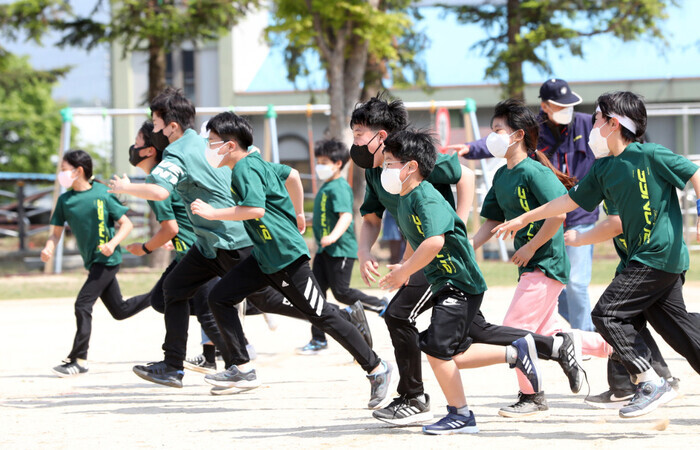hankyoreh
Links to other country sites 다른 나라 사이트 링크
All study and no play makes Korean teens less physically active than their grandparents

South Korean teenagers are being prevented from exercising at a time in their lives when they are recommended to engage in the most vigorous physical activity.
In most cases, their only exercise comes in the form of two or three hours a week of physical education at school, without any additional sporting activities after their classes. By an international standard, the data show South Korean teens to rank among the most sedentary with their daily routine.
Early this year, the Ministry of Culture, Sports and Tourism (MCST) released the findings of its 2021 national sport participation survey. The results showed 55% of teenage respondents answering that they exercised at least once a week for 30 minutes or more.
For half of teenagers, there is no exercise in their life outside of school. Their rate was lower than the 57%–63% shown by respondents in their 20s to 60s, and even the 58.3% recorded from respondents aged 70 and older.
While the figures do not include physical education at school, Korean and overseas statistics show that teenagers have ranked near the very bottom for physical activity since 2018.
With young people already short of opportunities to exercise, the COVID-19 pandemic has only exacerbated the situation.
Jung Hyun-woo, a senior research fellow at the Korea Institute of Sport Science, said, “Teenagers whose access to sports outside of school was already lower than that of adults suffered the biggest blow when COVID-19 stopped them from going to school.”
A 2020 research report by the Council of School Physical Education Promotion found that elementary and middle school students had gained an average of 4 to 5 kilograms during the pandemic, while their daily physical activity had declined by anywhere from 25 to 70 minutes.
Noting that the period from 5 to 17 years represents the optimal period for establishing a close relationship with exercise, the World Health Organization recommends that children in this age group should “do at least an average of 60 minutes per day of moderate-to-vigorous intensity” and “incorporate vigorous-intensity aerobic activities [. . .] at least 3 days a week.”
In the case of South Korean middle and high school students, a 2021 youth health practices survey showed just 30% engaging in high-intensity exercise at least three days a week of last year, and only 14.6% exercising 60 minutes or more five days a week.
A 2013 UNESCO survey found South Korean students had 120 minutes of elementary and middle school physical education per week, which was higher than the averages of 84–85 minutes for Asia as a whole and 105–109 minutes for Europe.
But they rank toward the bottom in terms of the rate of actual physical activity. A 2017 Organisation for Economic Co-operation and Development (OECD) survey found only 43% of South Korean students participated in physical activity after school — the lowest rate in the organization.
“It’s a good approach to do things the way South Korea does by guaranteeing physical activity through public education, in contrast with places like Canada that leave it up to the school or province’s discretion,” Jung Hyun-woo said.
“But the advanced countries all offer hands-on athletic instruction in local clubs outside of the schools. You can’t draw comparisons with those countries based on school [PE] hours alone,” he stressed.
“The reality of South Korean physical education in schools is the OECD finding placing us at the very bottom,” he said.
By Park Kang-su, staff reporter
Please direct questions or comments to [english@hani.co.kr]

Editorial・opinion
![[Editorial] Penalties for airing allegations against Korea’s first lady endanger free press [Editorial] Penalties for airing allegations against Korea’s first lady endanger free press](https://flexible.img.hani.co.kr/flexible/normal/500/300/imgdb/original/2024/0502/1817146398095106.jpg) [Editorial] Penalties for airing allegations against Korea’s first lady endanger free press
[Editorial] Penalties for airing allegations against Korea’s first lady endanger free press![[Editorial] Yoon must halt procurement of SM-3 interceptor missiles [Editorial] Yoon must halt procurement of SM-3 interceptor missiles](https://flexible.img.hani.co.kr/flexible/normal/500/300/imgdb/child/2024/0501/17145495551605_1717145495195344.jpg) [Editorial] Yoon must halt procurement of SM-3 interceptor missiles
[Editorial] Yoon must halt procurement of SM-3 interceptor missiles- [Guest essay] Maybe Korea’s rapid population decline is an opportunity, not a crisis
- [Column] Can Yoon steer diplomacy with Russia, China back on track?
- [Column] Season 2 of special prosecutor probe may be coming to Korea soon
- [Column] Park Geun-hye déjà vu in Yoon Suk-yeol
- [Editorial] New weight of N. Korea’s nuclear threats makes dialogue all the more urgent
- [Guest essay] The real reason Korea’s new right wants to dub Rhee a founding father
- [Column] ‘Choson’: Is it time we start referring to N. Korea in its own terms?
- [Editorial] Japan’s rewriting of history with Korea has gone too far
Most viewed articles
- 160% of young Koreans see no need to have kids after marriage
- 2[Editorial] Penalties for airing allegations against Korea’s first lady endanger free press
- 3Presidential office warns of veto in response to opposition passing special counsel probe act
- 4Hybe-Ador dispute shines light on pervasive issues behind K-pop’s tidy facade
- 5Months and months of overdue wages are pushing migrant workers in Korea into debt
- 6Japan says it’s not pressuring Naver to sell Line, but Korean insiders say otherwise
- 7S. Korea “monitoring developments” after report of secret Chinese police station in Seoul
- 8OECD upgrades Korea’s growth forecast from 2.2% to 2.6%
- 9[Reporter’s notebook] In Min’s world, she’s the artist — and NewJeans is her art
- 10[Guest essay] Maybe Korea’s rapid population decline is an opportunity, not a crisis